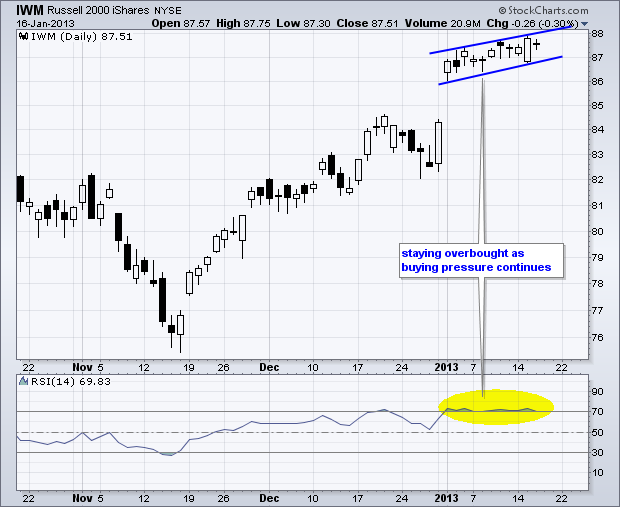Trading remains mixed overall, but the bias is still bullish as the major index ETFs hold their New Year's gains. SPY, MDY, QQEW and IWM have edged higher since gapping up on 2-Jan. QQQ, which has been weighed down by Apple, has traded flat. The bulls have the edge as long as the major index ETFs continue to labor higher. Also note that the Consumer Discretionary SPDR (XLY), Finance SPDR (XLF) and Industrials SPDR (XLI) recorded 52-week highs recently. They may be short-term overbought, but the medium and long-term trends are up. Earnings season is well underway now and next week will be the big week. The recent run-up in stocks suggests that earnings reports will be positive for the most part and positive earnings reports could keep stocks afloat for a few more weeks. Attention could then turn to the debt ceiling in the early-middle part of February. This could trigger some profit taking that would induce a correction.
 <
<
 <
<



**************************************************************************

**************************************************************************

**************************************************************************

**************************************************************************

**************************************************************************
Key Reports and Events:
Thu - Jan 17 - 08:30 - Jobless Claims
Thu - Jan 17 - 08:30 - Housing Starts/Building Permits
Thu - Jan 17 - 10:00 - Philadelphia Fed
Thu - Jan 17 - 10:30 - Natural Gas Inventories
Fri - Jan 18 - 09:55 - Michigan Sentiment
Wed - Jan 23 – 16:30 – Apple Earnings
Charts of Interest: Tuesday and Thursday
This commentary and charts-of-interest are designed to stimulate thinking. This analysis is
not a recommendation to buy, sell, hold or sell short any security (stock ETF or otherwise).
We all need to think for ourselves when it comes to trading our own accounts. First, it is
the only way to really learn. Second, we are the only ones responsible for our decisions.
Think of these charts as food for further analysis. Before making a trade, it is important
to have a plan. Plan the trade and trade the plan. Among other things, this includes setting
a trigger level, a target area and a stop-loss level. It is also important to plan for three
possible price movements: advance, decline or sideways. Have a plan for all three scenarios
BEFORE making the trade. Consider possible holding times. And finally, look at overall market
conditions and sector/industry performance.

About the author:
Arthur Hill, CMT, is the Chief Technical Strategist at TrendInvestorPro.com. Focusing predominantly on US equities and ETFs, his systematic approach of identifying trend, finding signals within the trend, and setting key price levels has made him an esteemed market technician. Arthur has written articles for numerous financial publications including Barrons and Stocks & Commodities Magazine. In addition to his Chartered Market Technician (CMT) designation, he holds an MBA from the Cass Business School at City University in London.
Learn More





